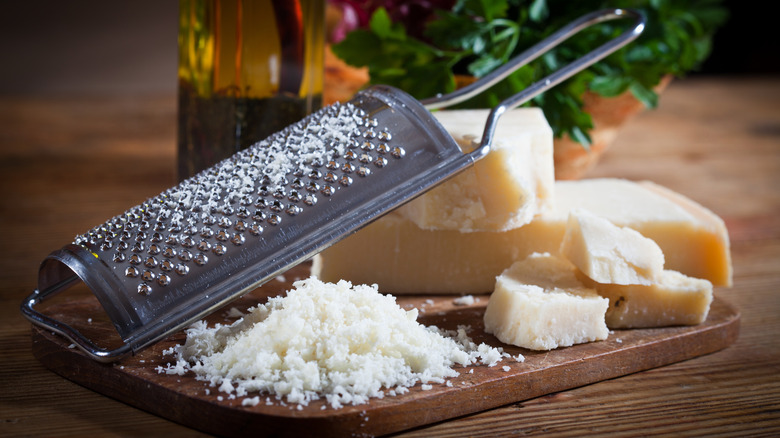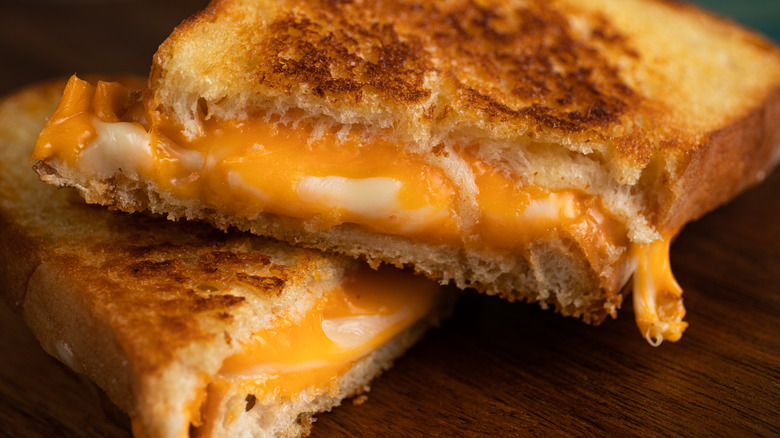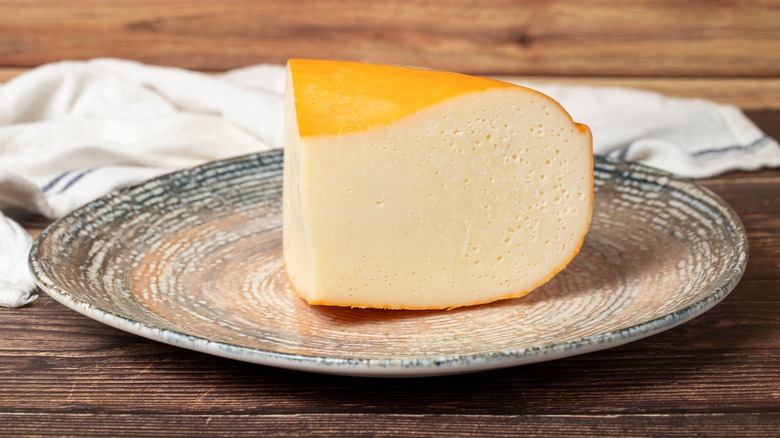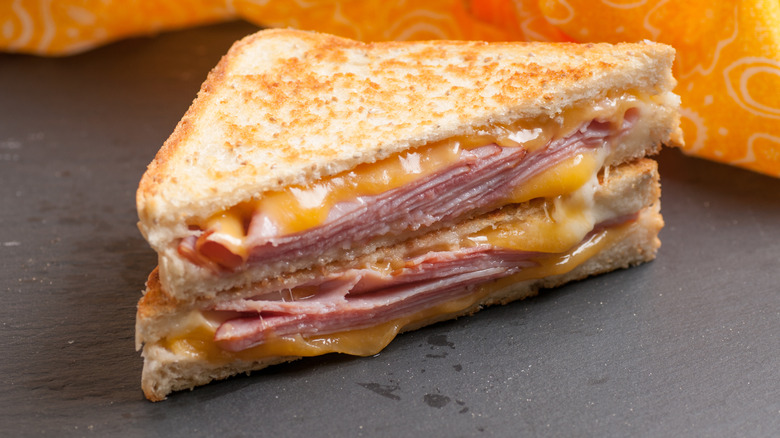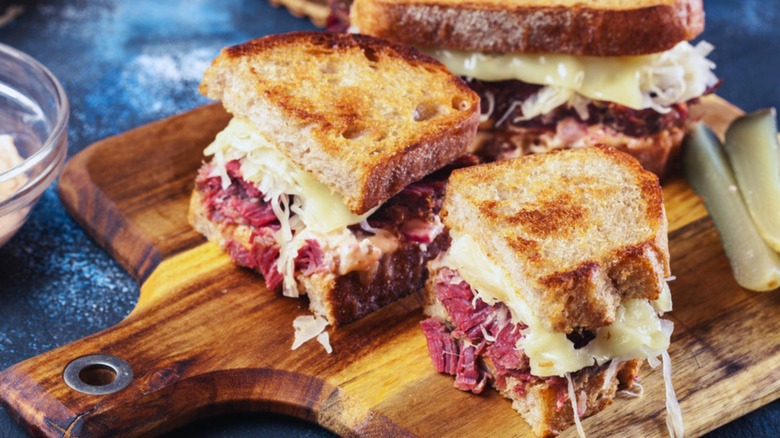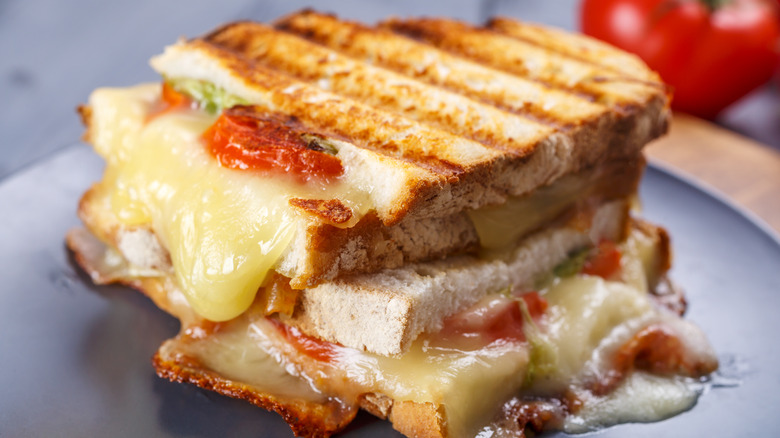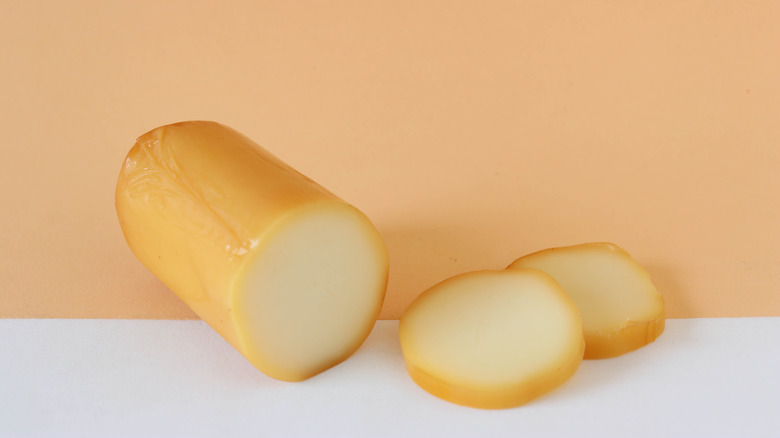14 Best Cheeses For Your Grilled Cheese Sandwich
There's nothing better on a cold winter day than a grilled cheese sandwich and a cup of warm tomato soup. While you may have fond memories of a slice of Kraft cheese sandwiched between the cheapest white sandwich bread you could find, there is so much more that's possible with this sandwich. One of the easiest ways to switch up your sandwich routine is to try a different cheese.
While there's nothing wrong with the standard Kraft single, there's a whole world of cheeses that are worth experimenting with. Varying aging periods, brine compositions, and flavorful add-ins all alter the consistency and flavor of the cheese and make every bite exciting when you sandwich it between two slices of bread. We've narrowed down some of the best cheeses that you should consider adding to your sandwich based on their flavor if they play well with other cheeses (and fillings), and if they produce the Instagram-worthy cheese pull that will satisfy your eyes as much as your belly.
Parmesan
Parmesan cheese is common for grating and sprinkling on top of a salad, but did you know it's also an ingredient that can give your grilled cheese a flavor upgrade? Although it's likely not on the menu at your favorite grilled cheese spot, the umami and nutty undertones of this cheese make it a great complement to the classic sandwich.
The best way to add this cheese to your sandwich isn't to open up the slices and sprinkle it in between. As you probably know, Parmesan cheese doesn't win any points for how well it melts. Instead, take your grilled cheese to the next level with a Parmesan crust. First, schmear a layer of mayonnaise or butter on the outside of your bread slices and pop it into your pan. The heat will crisp up the bread while also transforming the cheese into a consistency like Parmesan crackers. You can pair almost any cheese in your sandwich with this simple flavor-boosting hack.
Gruyére
Gruyére cheese is one of the ingredients you need to add to make the ultimate grilled cheese recipe. This type of cheese is commonly used in French onion soup because it melts easily and forms the perfect glob of cheesy goodness to complement the rich, thick broth.
The flavor of this cheese is creamy and delicate, but it really has a profound nuttiness that makes it worthy of this list. Plus, Gruyère cheese is so fatty that it melts easily, which is perfect for when you're craving a grilled cheese sandwich with the quintessential cheese pull. The major downside to this cheese is that you really have to pair it with a sharper-flavored variety, like a cheddar, to bolster the flavors. It's rare for you to find a Gruyère that's been aged more than six months, so expect a very mild flavor that can complement herbs, caramelized onions, or a meaty addition to your sandwich.
Brie
When you think of Brie, you likely think about the puff-pastry-wrapped baked cheese that's so satisfying to cut into. One delicate slice causes its contents to pour out onto the plate like a gooey river. So, imagine what a cheese like Brie could do for your sandwich.
Brie has a very high moisture content and is a soft cheese, so adding it to your sandwich will make for a melty, gooey mess. If you're working with this cheese for your grilled cheese, you have to remove the rind from it first. Although it's completely edible, the rind on this cheese will come out chewy, which will lead to an awkward mouthfeel if you leave it on your sandwich.
The ripeness and flavor of Brie really depend on how long it's aged. It can be punchier than expected for some palates, so you'll have to get creative when deciding how to tame the flavors with other ingredients. One possible rendition is a balsamic, mushroom, and onion grilled brie cheese sandwich. Brie is also a fantastic pairing with figs or fruit jam if you prefer to stay on the sweet side.
Cheddar
Cheddar is probably one of two cheeses you'd reach for when you whip up a classic (and kid-friendly) grilled cheese. The benefit of going with cheddar for a classic grilled cheese sandwich is that there are just so many different varieties of cheese to go for. The aging process affects the taste of the cheese, so you can select a sharpness that works for you. For example, if you're working with a sweet flavor from sliced apples, caramelized onions, or bacon, we recommend going with the sharpest variety you can find. But if you like mellow cheddar notes to complement herby notes, stick with a very young, white cheddar.
If you have enough time, we recommend grating your own cheese rather than using a bag of pre-grated cheddar from the grocery store. Pre-grated cheese often contains fillers that prevent the cheese from clumping up in the bag. So, the pre-packaged cheese will not melt as easily as if you took a box grater to your block of cheddar.
Cream cheese
Cream cheese probably does not come to mind first when you look into your fridge to decide what type of cheese you want to add to your sandwich. After all, isn't it just a spread for bagels?
The truth is that cream cheese can make a big difference to your sandwich. You should add a layer of cream cheese for a totally elevated grilled cheese. This soft, fresh cheese is deliciously moist, and although it won't contribute to the cheese pull, it will make the contrast between the crunchy, crisp bread and the soft filling a bit sharper. Plus, if you mix your cream cheese together with your other melting cheeses, like cheddar or American, you can expect the result to be much smoother. The only real flavor of cream cheese is a mild tang, which means that it's a welcomed pairing for sharper cheeses or mild varieties like mozzarella.
You can also whip up your cream cheese into a pimento grilled cheese sandwich by mixing it with cheddar, mayonnaise, and seasoning. It's a Southern twist on a timeless lunchtime recipe.
American
If you're not grabbing cheddar cheese for your sandwich, your second-best bet is American cheese. Although it's been relegated as a "plastic" cheese that should only ever be put in the trash can, this cheese, which surprisingly came from Switzerland, deserves a bit more appreciation. The primary component of the original American cheese was made from Emmentaler, a type of Swiss cheese. Eventually, James L. Kraft changed the recipe to use cheddar cheese, which he whisked perfectly so it would melt at 175 F. These chemical properties are the reason why a slice of American cheese melts well on grilled cheese, compared to both of its historical predecessors.
The next question regarding American cheese is whether you should use sliced cheese for your sandwich or stick to grating your own. The best option for your grilled cheese sandwich is to go with the latter because it more easily melts on your sandwich. But if you want to take the easy route and will take the trade-off of an uneven melt, then go with a slice.
There are many different pairings for an American grilled cheese sandwich. American cheese has a milder flavor than sharp cheddar, so it plays well with fillings that have a lot of flavor. If you're adding some shaved steak, turkey, or bacon to your sandwich, American cheese is a melty, neutral option. You can also add eggs and American to your sandwich to make a play on breakfast grilled cheese.
Gouda
This cheese is about as gouda as you can get. It's a Dutch cheese that's highly revered for its creamy texture. The taste is also subtly sweet and mild, with some sugary notes that pop through its unctuous consistency. This sweetness stems from the fact that the cheese curds are washed during the cooking process, which curbs the development of lactic acid in the dairy product.
Like other types of cheeses, the longer you age gouda, the drier the texture and flavor become. So, we prefer to go with a young gouda over an aged variety for our grilled cheese. We also recommend trying a smoked gouda rather than a plain one; it will add more complex notes to your sandwich. If you look hard, you'll even find gouda cheeses infused with different spices like fenugreek, cumin, and more.
To maximize the gouda's flavor, we like to pair it with savory ingredients and other types of cheese. For example, it's an excellent cheese pairing for umami-rich mushrooms, roasted red peppers, and caramelized onions. You can also stick with all things sweet here and pair your cheese with sliced apples, berries, or even a chutney.
Havarti
Havarti cheese is likely not a variety that you purchase regularly, but it is worth trying for your grilled cheese sandwiches. It's a Danish semi-hard cheese that is easy to slice and pair with a range of toppings. The cheese itself has notes of hazelnuts, which are developed more in aged cheeses than in young ones. We would argue that Havarti has a more complex taste than cheddar, with a more pronounced tang.
Havarti offers a blank canvas for flavor experimentation, but cheesemakers most commonly mix it with dill, horseradish, caraway seeds, and piquant peppers to give it a zing. Since this cheese is very buttery and rather soft, it makes an ideal addition to a grilled cheese sandwich, where it can melt with other cheeses like cheddar and Monterey Jack. There are only a few other toppings that won't mesh well with sturdy bread and Havarti cheese. Its tangy and subtly spicy profile is a solid pairing for bacon, avocado, and more.
Swiss
You might associate Swiss cheese with a classic Reuben sandwich, so it isn't far off to think that this cheese could be easily manipulated into a delicious grilled cheese sandwich, too. In fact, you can even make your Reuben into a grilled cheese version by placing the entire thing, corned beef, sauerkraut, and all, onto a grill pan and cooking it until the bread is crisp and the cheese is melty.
Swiss cheese encompasses everything that an Alpine cheese should be. It's a notably sweet cheese with a creamy texture and those quintessential holes across its surface. If you're looking for a superior cheese for melting, you'll want to go with a baby Swiss over a traditional one. The baby Swiss has a significantly shorter aging timeline, which means that the flavors don't develop as much, and the cheese retains its buttery, soft consistency.
Swiss cheese is also treated with a low-acid, low-salt brine, which means that its flavors are less well-developed than those of other cheese varieties. As a result, you can play with the saltier condiments, like a good Dijon mustard or even a salty coleslaw, to help bring your sandwich together.
Butterkäse
By the name, you can probably guess one distinct trait that this cheese has: butteriness. This German cheese really has everything that you could want from a good cheese — especially one that you'd want to use on your grilled cheese sandwich. The fat content of this cheese is around 50%, which produces a butter-like texture with every bite. The flavor of this cheese itself is a bit harder to explain, but some people have likened it to a gouda or Muenster.
Butterkäse is only aged for about a month, which helps preserve its delicate flavor and subtle sweetness. Like other soft, easily meltable cheeses (think Brie), Butterkäse is best paired with accompaniments that complement, rather than distract, from its profile. This is one cheese you'll want to pair with a drizzle of honey (or hot honey if you're feeling adventurous) or a salty Italian meat that will really be carried through with the buttery bite. Once you try it, we can assure you that it will be a game changer for every grilled cheese recipe you make at home going forward.
Mozzarella
Wait, this isn't a pizza! Although you might commonly associate a slather of gooey mozzarella on top of your pizza or layered on a Sunday night lasagna, it's one cheese that you'll want to try on your grilled cheese, too. Mozzarella is a fresh cheese with a high moisture content and a production process that involves heating and stretching the curd into thin, spindly webs. When the cheese is reheated, like when it's sandwiched between your bread, the cheese will stretch out yet again and give you the ultimate cheese pull.
The flavor of mozzarella is often described as milky and a little salty, but there is very little other flavor that comes through. This makes mozzarella a great base cheese to play with other flavors. Take your grilled cheese from good to gourmet by adding a layer of pesto, a sprinkle of mozzarella cheese, and a thinly sliced tomato. Finish your sliced off with a garlic of fresh basil, and you'll have a sandwich that is fit for a summer day.
Provolone
Provolone is a common sandwich topping, even when there's no grill involved. But if you want a truly flavorful addition to your grilled cheese, you might consider adding this cheese to the mix. It has about the same hardness as cheddar and can vary in flavors based on how long it's aged. The minimum aging threshold for this cheese is about two months, but there are also four-month (provolone dolce) and two-year (provolone piccante) varieties available at your local cheese counter.
Provolone has a tangier flavor than mozzarella cheese and a lower moisture content, which means it will be harder to melt than fresh cheese. But if you get a good heat on your pan and pair the provolone with a hearty white bread, you can trust that the sandwich you get out of it will be amazing. The salty and subtly nutty notes of provolone are a solid pairing for honey or cured Italian meats. You can even finish out your sandwich with a sprinkle of Chicago-style giardiniera for a pickled heat.
Monterey Jack
Monterey Jack is a unique cheese but is relatively common at the grocery store. This type of cheese has a light yellow hue and is often seen packaged into a Mexican blend with other cheeses like cheddar, asedero, and others. But if you can catch it alone, be sure to add it to your cart for the ultimate grilled cheese sandwich.
This cheese has a very high moisture content despite being a semi-hard cheese. As a result, it melts beautifully — which also makes it a great addition to queso. While it does need a bit of a punch from cheddar, or even Asiago, to help carry it in your sandwich, it can make for a dreamy cheese pull. We recommend going with a nod to the cheese's California heritage and sandwiching it with avocado, a bit of turkey bacon, and a drizzle of hot sauce to amp up your sandwich.
Fontina
Fontina is an Italian cheese that has made a name for itself in other cheese-loving parts of the world. Its flavor focuses mostly on roasted nuts and butter, with a slightly less sweet profile than other Italian cheeses. It's a great substitute for when you can't get your hands on Swiss cheese or if you're looking for a cheese that melts easily and can complement almost anything you pair it with.
Since nuts are the predominant flavor in this cheese, look for pairings that crave some earthiness of fatty reprieve. For example, a fruit jam can act as a bright, punchy contrast to the deeply flavored cheese. Or, you can pull inspiration from the Italian and Mediterranean regions where this cheese remains popular today and pair it with fresh summery tomatoes or roasted red peppers, leafy spinach, and more. Or, you can try out a Panera copycat fontina grilled cheese with a schmear of Boursin, a piece of provolone, and a hearty, thick white bread.
Static Media owns and operates Tasting Table and The Daily Meal.

